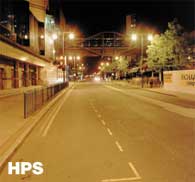| |
Photopic,
Scotopic And Mesopic Conditions
Lumens
are the standard measure of light output, but light is actually
defined as energy evaluated by the eye. Standard lumen measurements
define the light output response of a person only during high light
levels (called photopic light), typical of daylight and interior
lighting. The light meter measures photopic light as seen by the
central region of the eye.
When light levels
are very low, like starlight, the viewing conditions are referred
to as "scotopic." Under these conditions, the eye’s
visual response changes dramatically. Sensitivity to yellow and
red light is greatly reduced, while response to blue light is vastly
increased. If lamp lumens under scotopic viewing conditions have
been determined using photopic measurements, the lumen value does
not accurately measure the true amount of light production as perceived
by the human eye.
The eye response
does not shift suddenly from high light levels to low light levels.
A gradual change occurs as light levels are reduced in twilight
and typical street lighting conditions. This is the "mesopic"
condition in which the eye’s response lies somewhere between
photopic and scotopic.
Rods And
Cones
The
change in the eye’s spectral response is due to the presence
of two types of light receivers in the retina, called rods and cones.
Rods are responsible for human vision at low light levels and are
located in the peripheral field of view. Conversely, only objects
viewed directly by the eye are seen by the cones. Rods are sensitive
to scotopic light; cones react to photopic light. Therefore, as
the light level is reduced, cones become less active and rods become
more active.
back
to top
|
|
Eye Color
Sensitivity And Lumens
The
value of a lamp’s lumen output is different when considering
the shifting color sensitivity of the eye at low light levels. The
effective lumens will be different from the measured photopic lumens.
As light diminishes from photopic to scotopic conditions, the effective
lumens of yellow HPS light sources are reduced and the effective
lumens of white light with blue/green content increases.
This effect
is dramatic for low pressure sodium (LPS) lamps. Almost all energy
output from this lighting system is yellow, resulting in high photopic
lumen output. At low light levels, the effectiveness of LPS lamps
is drastically reduced.

back
to top
|
|
Metal Halide
Lamps For Low Light Levels
A typical metal halide lamp has strong light output
in the blue, green and yellow areas, resulting in high lumen output
at all light levels. The blue light output of metal halide is in
the high sensitivity region of the eye for low light levels. This
means that the effective lumens actually increase for a metal halide
lamp as the light level reduces and the eye shifts to a blue/green
peak sensitivity.
The ability
to detect fine contrast is also significantly better under metal
halide sources than sodium. Reaction time under LPS and HPS lighting
is roughly 50% longer than for metal halide. Therefore, the color
output of a light source has an important influence on safety. Studies
have shown that metal halide lighting, in some circumstances, can
be up to six times as effective as HPS. This can make a difference
in peripheral viewing and dark areas where hidden hazards may be
present.

back
to top
|
|

